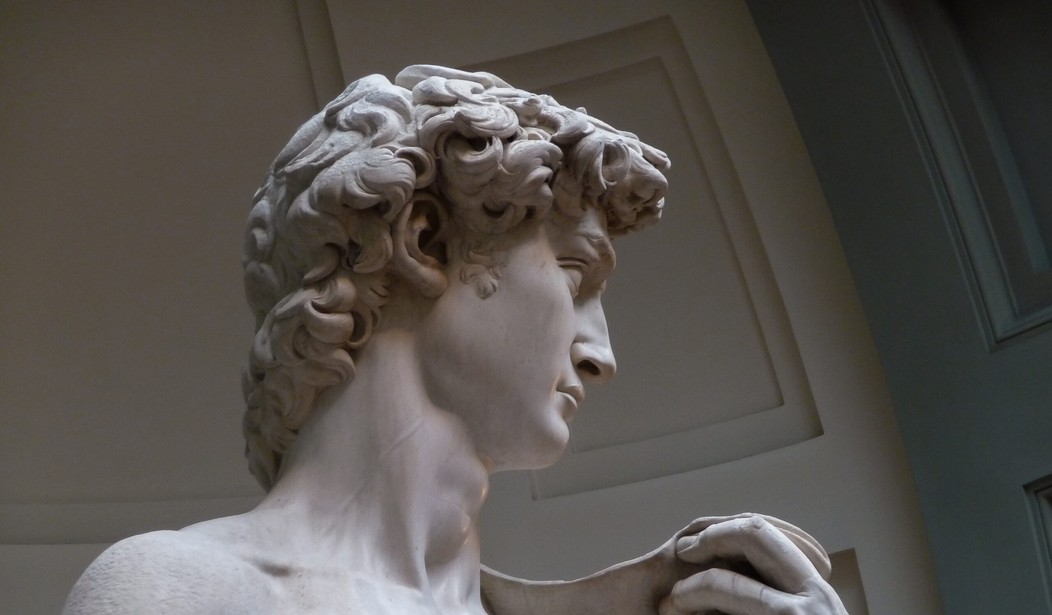Hillsdale College, a revered institution at which I have had the honor to lecture on several occasions, revoked the Tallahassee Classical School’s license to use its curriculum after the Florida institution fired its principal for showing a photo of Michelangelo’s nude statue of David without notifying parents. At least one parent considered the image pornographic. Hillsdale explained, “This drama around teaching Michelangelo’s ‘David” sculpture, one of the most important works of art in existence, has become a distraction from, and a parody of, the actual aims of classical education. Of course, Hillsdale’s K-12 art curriculum includes Michelangelo’s ‘David’ and other works of art that depict the human form.”
Hillsdale is right. But it’s complicated.
In 1999 my family vacationed in Italy, and I took my then eight-year-old daughter to the Academia Gallery in Florence to see the 1504 original. I told her the biblical story of the shepherd king depicted in the moment before he slung a stone at Goliath, and explained that Michelangelo changed the statue’s bodily dimensions to adjust to the point of view of spectators viewing it from below.
After I had droned on for a while, my daughter said, “Dad, was Michelangelo gay?” Out of the mouths of babes and sucklings. The great artist probably was, although scholars think the evidence is inconclusive. My professional field is music, not plastic arts, so I will offer no opinion on the quality of work, except to say that his great sculptures are stunning to behold in person.
Whatever the merits of the “David” as a work of art, Michelangelo gave us a Greek hero rather than a biblical figure. Art historians note that the so-called contrapposto twist of David’s torso as he prepares to release his sling is common in ancient Greek sculpture starting with Polykleitos’ 5th-century B.C.E. spear-bearer.
No Hebrew would exercise, much less fight, in the nude. On the contrary, rabbinic tradition (as reported by the late Rabbi Joseph Soloveitchik) reports that the Maccabean rebellion against Greek rule over Judea was provoked by the Greek fashion of nude exercise, adopted by assimilated Jews of the 2nd century B.C.E. The human form is beautiful, to be sure, but it is more than that: It is sacred, and what is sacred must be hidden from the leers of the crowd. The Hebrew word for sanctity connotes separation. Only within the sanctified confines of marriage should the human body be revealed in its nakedness.
David and his descendants were promised the kingship of Israel in perpetuity not because he was a Hebrew Hercules or Achilles, but rather because of his capacity to repent, as in Psalm 51. Moral grandeur, not physical beauty, defined the Davidic line.
The bodily form of Michelangelo’s nude is beautiful. But the human form is also disturbing, precisely because it is mortal: The perfect proportions and sleek muscle one day will be food for worms. The Greeks immortalized their well-proportioned gods and goddesses, and in their art sought to assign a kind of immortality to the passing beauty of youth. That is a mask for mortality. No-one saw through this mask with more cunning than Friedrich Nietzsche, who wrote in The Birth of Tragedy:
There is an ancient story that king Midas hunted in the forest a long time for the wise Silenus, the companion of Dionysus, without capturing him. When at last he fell into his hands, the king asked what was best of all and most desirable for man. Fixed and immovable, the demon remained silent ; till at last, forced by the king, he broke out with shrill laughter into these words: “Oh, wretched race of a day, children of chance and misery, why do ye compel me to say to you what it were most expedient for you not to hear? What is best of all is forever beyond your reach: not to be born, not to be, to be nothing. The second best for you, however, is soon to die.”
Nietzsche continues:
How is the Olympian world of deities related to this folk-wisdom? Even as the rapturous vision of the tortured martyr to his sufferings. Now the Olympian magic mountain opens, as it were, to our view and shows to us its roots. The Greek knew and felt the terrors and horrors of existence: to be able to live at all, he had to interpose the shining dream-birth of the Olympian world between himself and them.
The artist’s attempt to freeze the beauty of the flesh into a moment in marble is a protest against mortality, just as Nietzsche wrote. For his own part, Nietzsche desired that moment more than anything else. The Drunkard in Thus Spake Zarathustra” embraces Mephistopheles’ side of Faust’s wager: He desires a moment so beautiful that it will make him want it to last forever. Nietzsche knows that he has damned himself, but he can’t help it. Dionysian wantonness is the evil twin of Apollonian beauty.
Our mortality is always lurking in the tall grass when we indulge in the aesthetic contemplation of the beautiful. Pornography is a degenerate form of aesthetic attitude: It reduces Mephisto’s moment of beauty to a momentary physical pleasure.
“Grace is false and beauty is fleeting,” Solomon warned (Proverbs 31). Many conservatives long for the restoration of classical beauty as a fundament of Western civilization. But we can’t go back there, because there never was a “there” in the first place. The classical ideal of beauty, as Nietzsche said, was a veil for the “terrors and horrors of existence.” Art that confronts these terrors can evoke the courage to live. Contrast to Michelangelo’s “David” Raphael’s 1520 “Transfiguration of Christ,” for example. Kant in his Critique of Judgment has the first clear distinction between the beautiful, which always pleases, and the sublime, which well may disturb by evoking the infinite. A rose is beautiful; a storm at sea is sublime. “David” is beautiful; Rembrandt’s portraits of elderly subjects are sublime. Unless we are able to confront the infinite—most poignantly in the form of our mortality—beauty will not avail us.










Join the conversation as a VIP Member